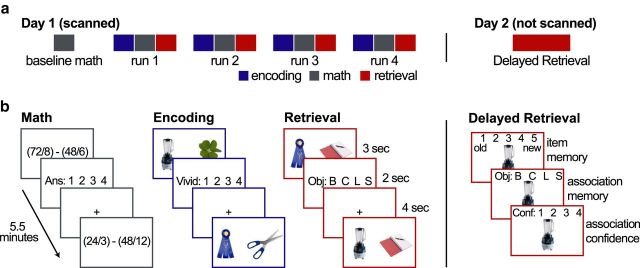Figure 1.
Experimental design. a, Schematic illustration of session structure. The experiment was conducted over 2 d. The first day, which was scanned, began with a baseline math block followed by four cycles of encoding, math, and retrieval blocks. Each block was 5.5 min long. Participants returned the following day for the un-scanned Delayed Retrieval test. b, Example trials for each task. In the Math Task, participants answered arithmetic problems. The solution was always 1, 2, 3, or 4. In the Encoding Task, participants formed mental images of two objects interacting. The left object was always unique to the trial, and the right one was selected from a set of four repeating objects. Participants rated the vividness of their imagery on a scale from 1 to 4. In the Retrieval Task, participants recalled which of the four repeated objects was paired with the object on the left side of the screen. The notebook image on the right side of the screen served as a placeholder for the target object. The Delayed Retrieval Task had three steps. First, participants indicated whether an object was studied the day before or if it was new (item memory). Next, if the participants thought the object was old, they were asked whether they could remember which repeated object was paired with it (associative memory). Finally, if they recalled the associated object, they were asked how confident they were on a scale from 1 to 4. In all tasks, participants were given the option to indicate that they were unsuccessful rather than guessing.

